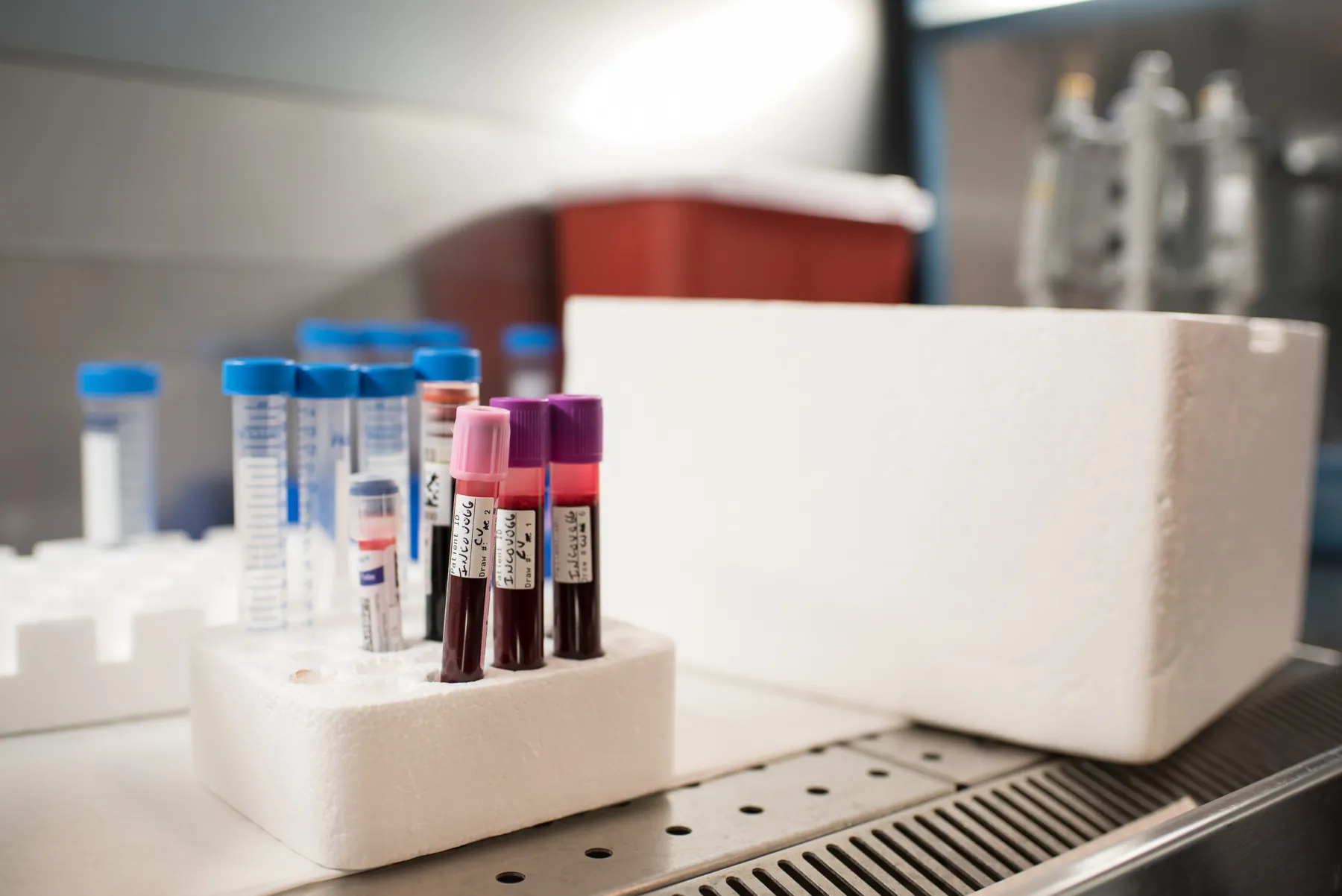New Therapies for Genetic Anemia
Thalassemia, an inherited disorder that affects the production of healthy red blood cells causing mild to severe anemia, is treated with blood/iron transfusions or stem cell transplants. The Ranish Lab, with NIH funding, is investigating the red blood cell creation process to develop new therapeutic strategies for fetal and adult thalassemia and other red blood cell disorders.

Blood samples in a sterile hood at ISB. Photo credit: Victorial Uhl / ISB.
The generation of new red blood cells from stem cells in our bone marrow, known as erythropoiesis, is a critical and continuous process throughout our lives. In people with thalassemia, a genetic disease that results in low levels of oxygen-bearing hemoglobin, or other kinds of genetic anemia, erythropoiesis does not function as it should. ISB’s Jeff Ranish, PhD, is leading a project to understand the regulatory network that governs healthy red blood cell development by focusing on the proteins that guide gene expression changes during this process. These gene-regulating proteins, known as transcription factors, are highly dynamic during the course of erythropoiesis. Ranish and his colleagues have developed new mass spectrometry-based methods to quantify transcription factor abundance during erythropoiesis and are building computational models of the erythropoiesis regulatory network that emerges from the data they collect. Understanding how red blood cells are generated in healthy people is a key first step toward designing new therapeutics to boost healthy blood cell production in blood disorders like thalassemia.
- Funded by National Institute of Diabetes and Digestive and Kidney Diseases
- Led by Jeff Ranish, PhD
- Key collaborators:
- Marjorie Brand, PhD, University of Wisconsin-Madison
- Sushmita Roy, PhD, University of Wisconsin-Madison
The proteins that control red blood cell formation
Previous research attempting to decode the erythropoiesis transcriptional regulatory network, the system of how genes are switched on and off, focused primarily on gene expression levels of transcription factors, looking at the amount of RNA corresponding to the transcription factors as a proxy for their protein levels. But RNA levels do not always correspond to protein amounts: Ranish and his colleagues found that transcription factors involved in erythropoiesis are often present in very different amounts than their RNA levels would suggest. To build a more accurate transcriptional regulatory network of erythropoiesis using protein levels, the team turned to mass spectrometry, a method that captures accurate amounts of many different proteins in a single sample. The team is using samples taken over several time points as stem cells develop into mature red blood cells to understand how transcription factor levels change during the entire process. This information is then integrated with measurements of RNA levels, chromatin accessibility, and transcription factor localization throughout the genome, to build erythropoiesis gene regulatory models.
They’ve adapted several different kinds of mass spectrometry methods to study erythropoiesis. One, known as data-independent acquisition (DIA) mass spectrometry, gives reproducible readouts of relative levels of thousands of proteins in a single analysis. Another, parallel reaction monitoring or selected reaction monitoring (PRM/SRM) mass spectrometry, gives highly sensitive measurements of a smaller number of proteins. Finally, a technique known as QconCAT uses labeled protein standards to read out absolute protein abundance during either DIA or PRM/SRM-mass spectrometry analysis. Currently, the team is able to measure around 100 proteins at once using QconCAT; they’re working to push that up to 1000 proteins in one experiment, around half of the total number of different human transcription factors.
In their studies so far, the team has, for the first time, successfully integrated protein measurements of transcription factors into transcriptional regulatory network models of erythropoiesis. They’ve also quantified proteins that act together with transcription factors to influence gene expression, proteins that are known as co-repressors (which work to switch off genes) and co-activators (which switch on genes). That study found that co-activators are present in much smaller amounts in developing red blood cells than either transcription factors or co-repressors, meaning that co-activators may be the limiting factor in determining gene expression.
In future work, they’re hoping to use the same techniques to study erythropoiesis in cells taken from people with thalassemia to understand how the transcriptional regulatory network is affected in this form of genetic anemia. Ultimately, understanding the proteins involved in erythropoiesis could help scientists design therapies that dial up or down different transcription factors to correct deviations in blood cell development in thalassemia or other red blood cell disorders.
Citations
- Brand M, Ranish JA. Proteomic/transcriptomic analysis of erythropoiesis. Curr Opin Hematol. 2021. doi: 10.1097/MOH.0000000000000647.
- Gillespie MA, Palii CG, Sanchez-Taltavull D, Shannon P, Longabaugh WJR, Downes DJ, Sivaraman K, Espinoza HM, Hughes JR, Price ND, Perkins TJ, Ranish JA, Brand M. Absolute Quantification of Transcription Factors Reveals Principles of Gene Regulation in Erythropoiesis. Mol Cell. 2020. doi: 10.17632/75vs43ydbf.1.
- Gillespie MA, Palii CG, Sanchez-Taltavull D, Perkins TJ, Brand M, Ranish JA. Absolute quantification of transcription factors in human erythropoiesis using selected reaction monitoring mass spectrometry. STAR Protoc. 2020. doi: 10.1016/j.xpro.2020.100216.
- Palii CG, Cheng Q, Gillespie MA, Shannon P, Mazurczyk M, Napolitani G, Price ND, Ranish JA, Morrissey E, Higgs DR, Brand M. Single-Cell Proteomics Reveal that Quantitative Changes in Co-expressed Lineage-Specific Transcription Factors Determine Cell Fate. Cell Stem Cell. 2019. doi: 10.1016/j.stem.2019.02.006.
Technologies Developed
Selected reaction monitoring-mass spectrometry assays for over 100 human transcription factors
QconCAT mass spectrometry technology for absolute quantification of human transcription factors

Contact Dr. Jeff Ranish
Professor
ISB